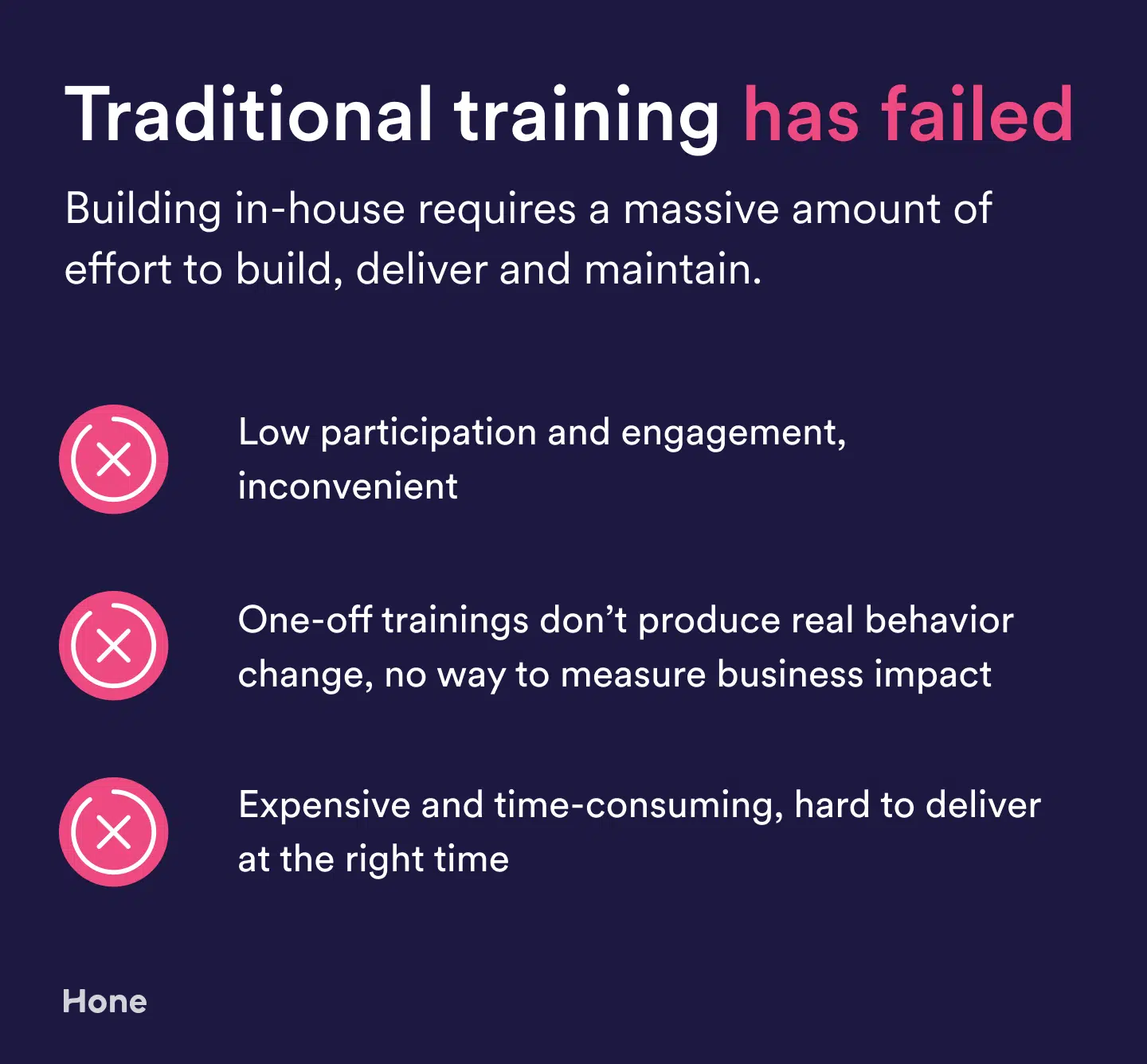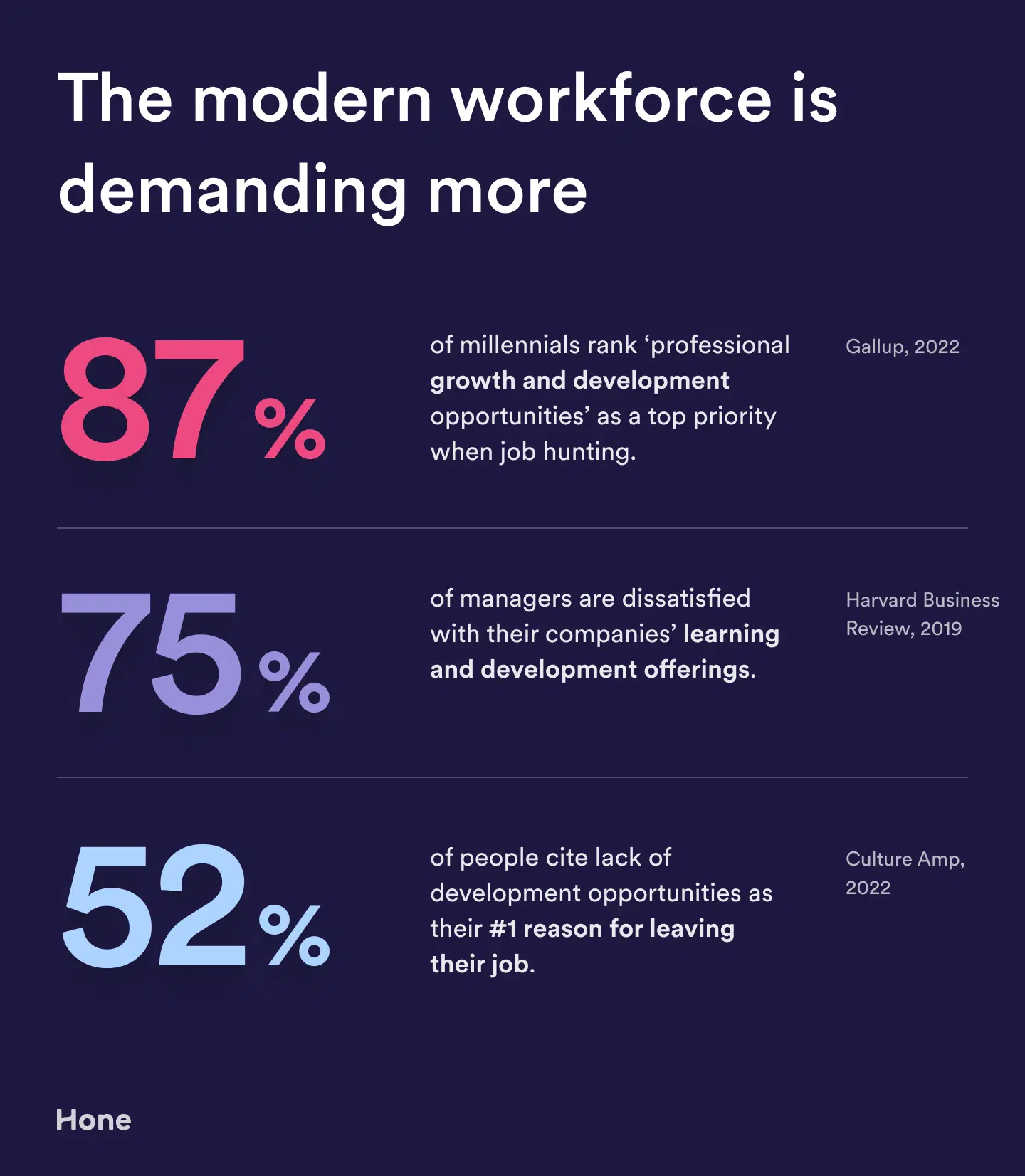It’s no surprise that L&D teams are stretched thin. On top of being responsible for training and upskilling an entire workforce, L&D teams often have to justify their impact on the organization and defend their budgets. Unfortunately, proving impact can be tricky since measuring the ROI of L&D initiatives and training programs isn’t always straightforward or easily quantifiable.
While L&D teams often try to measure the significance of their programs using metrics like attendance rates, employee course satisfaction scores, post-course assessments, these results are one-dimensional and don’t convey the full impact of a training program on your workforce. The fact that 75% of your employees attended your program doesn’t mean much if none of them are using what they learned 3, 6, or 9 months after the program.

So, how can L&D teams juggle training employees with proving their worth? According to Jenny Dearborn, the Chief People Officer for Klaviyo, the answer is simple: throw traditional L&D metrics to the curb. Instead, she says, L&D professionals must focus on behavioral change.
In Hone’s latest Learning Leaders event, we sat down with Dearborn to better understand how modern L&D teams can prove the impact of their programs using cutting-edge behavioral change metrics. Here’s what she had to share:
How The Pandemic Changed L&D for The Better
While the pandemic has brought its fair share of challenges, it’s also brought opportunities.

Most obviously, the biggest challenge was figuring out how to train a distributed workforce, especially with traditional co-located, face-to-face learning out of the question. Talent development teams had to find a way to train teams all over the world — and fast. Luckily, remote options like live online classes empowered L&D teams to both reach employees wherever they are, and to do it at scale.
Furthermore, we have also had to confront a shift in training needs. In the past, technical skills were in high demand. But as the world shifted to virtual overnight, there has been an increased, urgent need for upskilling employee’s emotional intelligence skills like empathy, communication, and leadership.
On the other hand, the pandemic has proven how crucial L&D teams are to business success. The rapid shift to a distributed workforce in an era of uncertainty, as well as the emotional intelligence needed to keep teams and businesses healthy, have given L&D a chance to shine: thanks to learning professionals, managers, people leaders, and employees quickly deepened skills in communication, leading through turbulent times, maximizing productivity, taking care of their own well-being, etc. Without L&D teams to identify the skills their employees needed to succeed in our new world and to guide the upskilling process, both businesses and employees would have greatly suffered.
“This is the greatest opportunity in our lives as people professionals to show our tremendous value,” urged Dearborn. “The global pilot that we’re doing with this pandemic is a forcing function for change. This is really the tipping point — learning and development and all things people have never been more important.”
Why You Need to Ditch Traditional L&D Metrics
When you launch a new training program, it’s tempting to want results immediately. That’s why we often focus on surface-level metrics like attendance rates, employee course satisfaction scores, and post-course assessment scores. That said, if you track those metrics, you’re already ahead of the curve: McKinsey research found that only 50 percent of businesses keep track of participants’ feedback about training programs. Shockingly, only 30 percent use any kind of metric to track program efficiency.

While we’re not saying you should abandon these metrics altogether, you should take them with a grain of salt. “L&D has, in the past, gotten in trouble when we have been output, volume, and activity metrics oriented,” reminded Dearborn. “We’ve said, ‘But, everybody gave it a 4.5 out of 5 stars, or 450 people out of the 500 in the target audience attended!’ Who gives a crap? I don’t care if everybody went if it was a terrible class. That’s a waste of time.”
Instead of focusing on those preliminary metrics, Dearborn urges you to go even further. Ask yourself what outcomes you’re trying to achieve and find a way to measure success in a way that aligns more closely to those goals. “You need to know your job is to drive the outcome of changing behavior that drives business performance. If you could do that by only training 10% of the people, all the better, right?,” stated Dearnborn. “Don’t focus on the volume metrics and the activity metrics, focus on the outcome you’re trying to achieve.”
Why Behavioral Change Should Be Your Most Important KPI
Trying to earn more credibility with your stakeholders? You have to think like they do, then appeal to their motivations. Ask yourself: what is the outcome our business wants? Often, this centers around tangible behavioral change in your business.
For example, let’s say your stakeholders want to understand the impact of L&D on employee performance. Do you have a way of measuring employee performance and understanding who is exceeding, meeting, or failing to meet expectations? If you do, you can take that data and map it against attendance records of your learning events to better understand the impact your programs have on your workforce. If you can determine that everybody who attended a specific training program exceeds expectations, while the majority of employees who didn’t attend this program inconsistently meet expectations, you can create a compelling narrative around why this type of training matters. That’s a great way of showing value to your executive clients and securing budget.
Just empathizing with your stakeholders places you ahead of most L&D teams. In fact, only 40 percent of companies say their learning strategy is aligned with business goals. Put another way, over 60 percent of L&D programs have no explicit connection to a company’s strategic objectives!
Take a step back and consider what outcomes your business is trying to achieve, suggests Dearborn. Define the behaviors, knowledge, skills, abilities, competencies that your key roles need to be successful, and then determine how you can effectively teach employees those skills, so you can drive business impact.
“Trained sales reps yield higher revenue. Trained engineers write code that takes less server time. Trained customer support reps have a higher NPS score. Marrying business impact results with learning deliverable results will give you more credibility with the business. That’s how to have a conversation about how you’re not wasting time,” said Dearborn.
—
This article was an excerpt from a recent Learning Leaders event.
Learning Leaders is the premier community for L&D leaders and industry experts to come together and share expert knowledge, best practices, and overcome today’s challenges together. Click here to apply for membership today.













